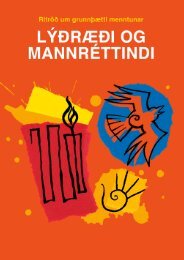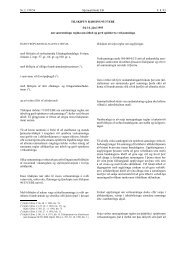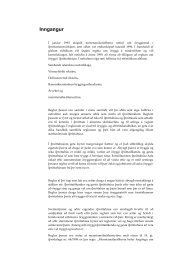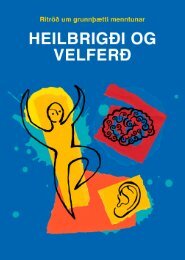Arts and Cultural Education in Iceland : Professor Anne Bamford
Arts and Cultural Education in Iceland : Professor Anne Bamford
Arts and Cultural Education in Iceland : Professor Anne Bamford
You also want an ePaper? Increase the reach of your titles
YUMPU automatically turns print PDFs into web optimized ePapers that Google loves.
By contrast, <strong>in</strong> many schools <strong>and</strong> colleges visited there was wonderful practice go<strong>in</strong>g on<br />
beh<strong>in</strong>d the closed doors of classrooms, but this was not evident through displays or other<br />
presentations of work. Generally there was a lack of attention given to the value of pupils be<strong>in</strong>g<br />
able to present their work <strong>in</strong> a high quality <strong>and</strong> professional manner. While <strong>in</strong> the pre-primary<br />
school <strong>and</strong> primary years, this process may be led – or ideally mediated – by the teacher, <strong>in</strong> later<br />
years, pupils need to be explicitly taught how to present their work <strong>in</strong> all forms, <strong>in</strong>clud<strong>in</strong>g oral<br />
presentation.<br />
While a number of schools had performances to co<strong>in</strong>cide with festivals, it is important that<br />
projects <strong>and</strong> learn<strong>in</strong>g l<strong>in</strong>es culm<strong>in</strong>ate <strong>in</strong> a high quality presentation of the learn<strong>in</strong>g process. In<br />
some schools this was evident.<br />
In the perform<strong>in</strong>g arts, several schools visited had regular opportunities for pupils to<br />
perform <strong>in</strong> a professional or community environment. Performance <strong>and</strong> exhibition as part of a<br />
high quality arts programme build a child’s confidence, dedication <strong>and</strong> commitment to the arts<br />
<strong>and</strong> are – for most pupils – memorable highlights of their school life.<br />
It is important also, that follow<strong>in</strong>g performances <strong>and</strong> exhibitions, pupils are given the<br />
opportunity to reflect, articulate <strong>and</strong> evaluate their learn<strong>in</strong>g <strong>and</strong> propose future projects. This<br />
process is significant <strong>and</strong> it cannot be assumed that pupils will do this without a process of<br />
careful facilitation. The learn<strong>in</strong>g that occurs with<strong>in</strong> the arts must be made explicit to children <strong>and</strong><br />
derived from their first-h<strong>and</strong> experiences so that pupils have a concrete way to connect learn<strong>in</strong>g.<br />
The follow<strong>in</strong>g vignette (3.3.1) describes a performance opportunity <strong>in</strong> a compulsory school that<br />
regularly encourages its pupils to perform.<br />
Vignette 3.3.1 The children are aware of audience protocols<br />
The hall is <strong>in</strong> the centre of the school. At least once a week, a class has to perform <strong>and</strong> <strong>in</strong>vite their ‘buddy class’ as an<br />
audience. The class I am watch<strong>in</strong>g is a grade 7. The children have organised the concert. Some children are sign<strong>in</strong>g <strong>and</strong><br />
other danc<strong>in</strong>g. There is no school b<strong>and</strong>, but there are several choirs <strong>and</strong> s<strong>in</strong>g<strong>in</strong>g groups. Despite the impromptu nature<br />
of the concert, there is a backdrop <strong>and</strong> the hall has the feel of be<strong>in</strong>g a performance space. There are an excellent<br />
range of good quality <strong>in</strong>struments available.<br />
The quality of the s<strong>in</strong>g<strong>in</strong>g is very good, <strong>and</strong> the projected words encourage all the audience to jo<strong>in</strong> <strong>in</strong> as well. The<br />
s<strong>in</strong>g<strong>in</strong>g is loud <strong>and</strong> confident. The other teachers <strong>in</strong> the group are not jo<strong>in</strong><strong>in</strong>g <strong>in</strong>. The children are aware of audience<br />
protocols <strong>and</strong> behave well dur<strong>in</strong>g the performances. A child compares the show. Another teacher is video<strong>in</strong>g the<br />
show. They usually document their concerts. The concert progresses <strong>and</strong> the children <strong>in</strong> the audience spontaneously<br />
jo<strong>in</strong> <strong>in</strong> clapp<strong>in</strong>g the African rhythms. The performance ends. The performers bow <strong>and</strong> the audience of younger<br />
children clap enthusiastically.<br />
62



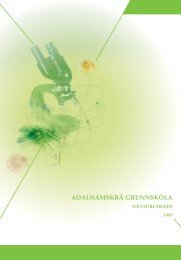
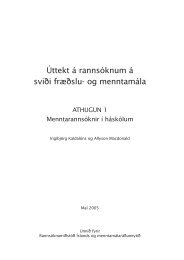

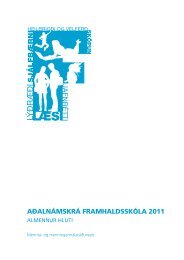
![Aðalnámskrá tónlistarskóla : rytmÃsk tónlist [Eingöngu á rafrænu formi]](https://img.yumpu.com/50843672/1/184x260/aaalnamskra-tanlistarskala-rytma-sk-tanlist-eingangu-a-rafranu-formi.jpg?quality=85)
